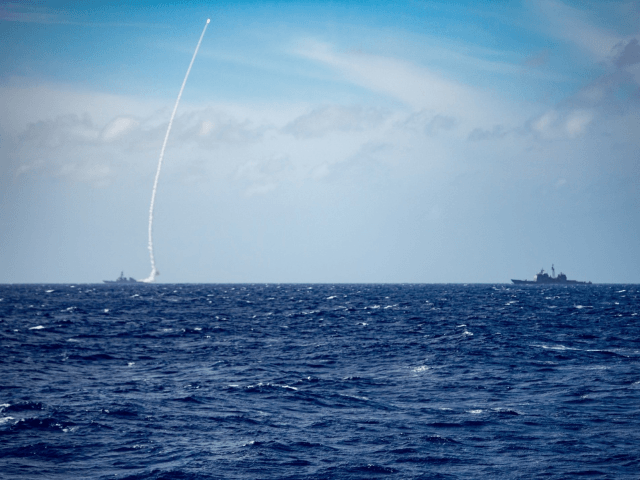The U.S. Navy launched live-fire missile tests in the Philippine Sea, it revealed this week, to warn China that the U.S. remains ready to intercept new Chinese missiles, military analysts said.
The drill took place in the waters east of the Philippines – pertaining to the highly contested South China Sea, claimed almost entirely by China – on Thursday, according to the U.S. Seventh Fleet’s Facebook page. The guided-missile destroyer USS Barry launched a medium-range Standard Missile-2, accompanied by the guided-missile cruiser USS Shiloh, which also launched an SM-2 during the drill.
The Navy drill in the Philippine Sea comes in response to Beijing’s announcement last week that it had built two new “research stations” or military installations on nearby reefs claimed by the Philippines and others, evidence of China’s ongoing expansion in the region.
In recent years, China has exerted increasing control in the nearby South China Sea, claiming zones traditionally considered international territory, or as pertaining to nearby Southeast Asian nations. Many, including the U.S., consider the action part of the country’s efforts to transform itself into a major global power.
Earlier in March, Chinese state media suggested the possibility of using an electromagnetic pulse weapon (EMP) against American ships entering the South China Sea.
The U.S. has increased its presence in the region in recent years as well, aiding Southeast Asian nations in their efforts to fight China’s encroachment in the waters. This show of force by the U.S. in the South China Sea has been met with resistance by China, escalating tensions there.
PHILIPPINE SEA (Mar. 19, 2020) The Arleigh Burke-class guided-missile destroyer USS Barry (DDG 52) launches a missile…
Posted by U.S. 7th Fleet on Sunday, March 22, 2020
“The Arleigh Burke-class guided-missile destroyer USS Barry – DDG 52 launched a missile during a live-fire exercise and conducted combat information center operations. Barry is underway conducting operations in support of security and stability in the Indo-Pacific,” The U.S. Seventh Fleet’s Facebook page announced on Sunday.
Commenting on the exercise, Asian military analysts spoke to the South China Morning Post (SCMP) on Tuesday. These kinds of drills are not common and “could be seen as a warning to the People’s Liberation Army,” Beijing-based military specialist Zhou Chenming told the newspaper.
He added, “The U.S. Navy is worried about Chinese missiles, which China could use as a trump card in a military conflict between the two parties in the region. The Seventh Fleet wants to warn Beijing that it can intercept missiles from China.”
China’s People’s Liberation Army (PLA) has developed two kinds of missiles that could pose major threats to the U.S. military. The DF-21D, called the “carrier killer,” and the anti-ship DF-26, which has a 2,500 mile (4,000 km) range, placing the U.S. naval base in Guam – a U.S. territory in the western Pacific Ocean – within reach.
China may have tested either one of these new missiles in June during a staged missile test by the PLA Rocket Force. According to the Pentagon, the “disturbing” test took place last summer in the Philippine Sea (the marginal sea east and northeast of the Philippines).
Equipped with the latest Aegis combat system, the USS Barry boasts an improved ability to defend bases like Guam and U.S. warships from the two types of Chinese missiles.
Both the U.S. and China may escalate the number of tests as the rival militaries attempt to close the hardware, software, and training gap between the two forces, Colin Koh Swee Lean, a research fellow with the Institute of Defence and Strategic Studies’ Maritime Security Programme in Singapore, told the SCMP.
“Given the shift in defense focus to the Indo-Pacific and with the PLA threat in mind, I wouldn’t be surprised if the U.S. Navy conducted more such live-fire exercises to validate the fleet’s capabilities against the evolving PLA missile strength,” Koh said.
The Philippine Sea would be a significant battlefield in any future China-U.S. armed conflict, according to Koh. The missile launches come as the U.S. military strengthens ties with regional allies, like the Philippines, Vietnam, and others, as part of its Indo-Pacific strategy to curb China’s power in the highly contested South China Sea.

COMMENTS
Please let us know if you're having issues with commenting.